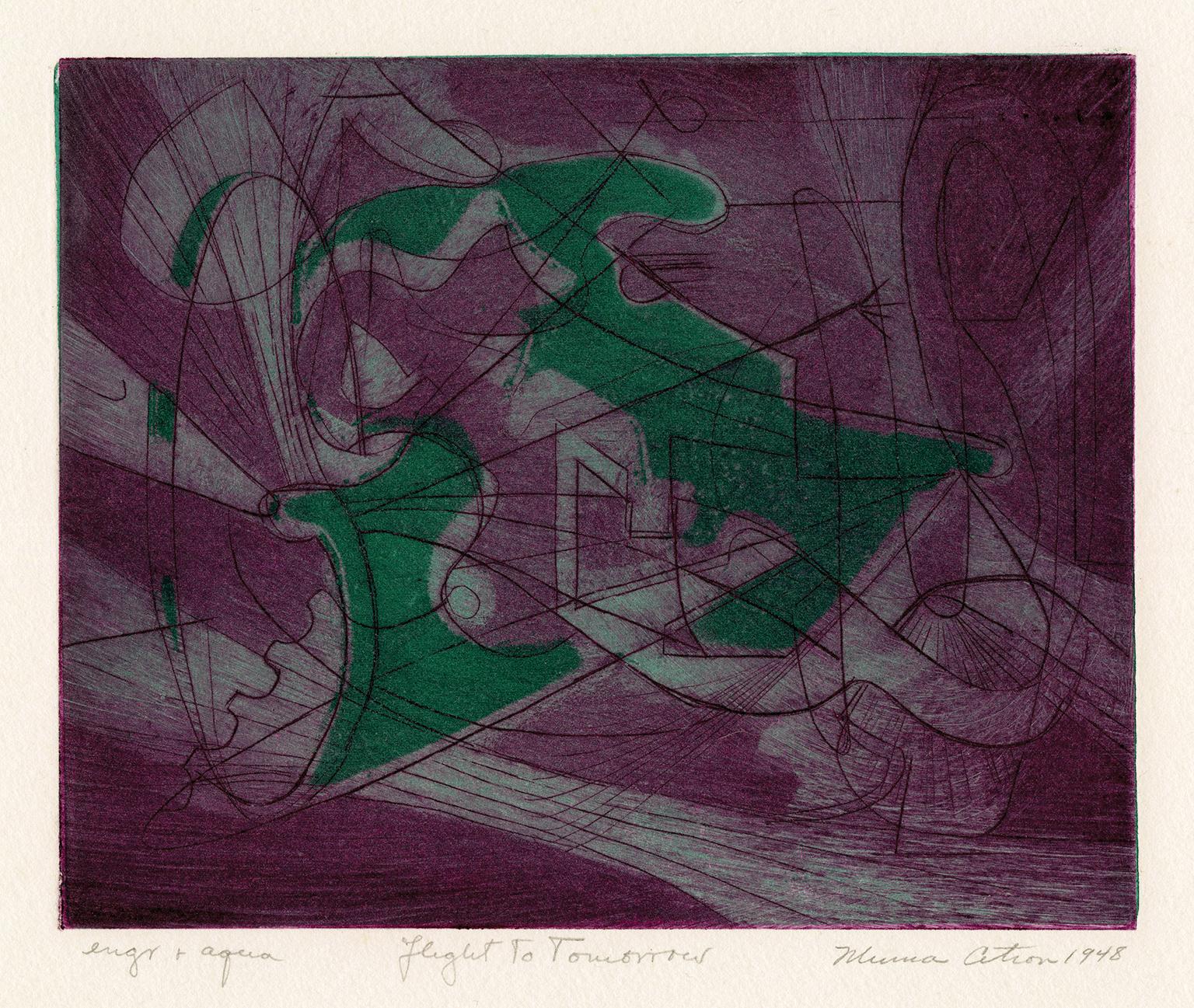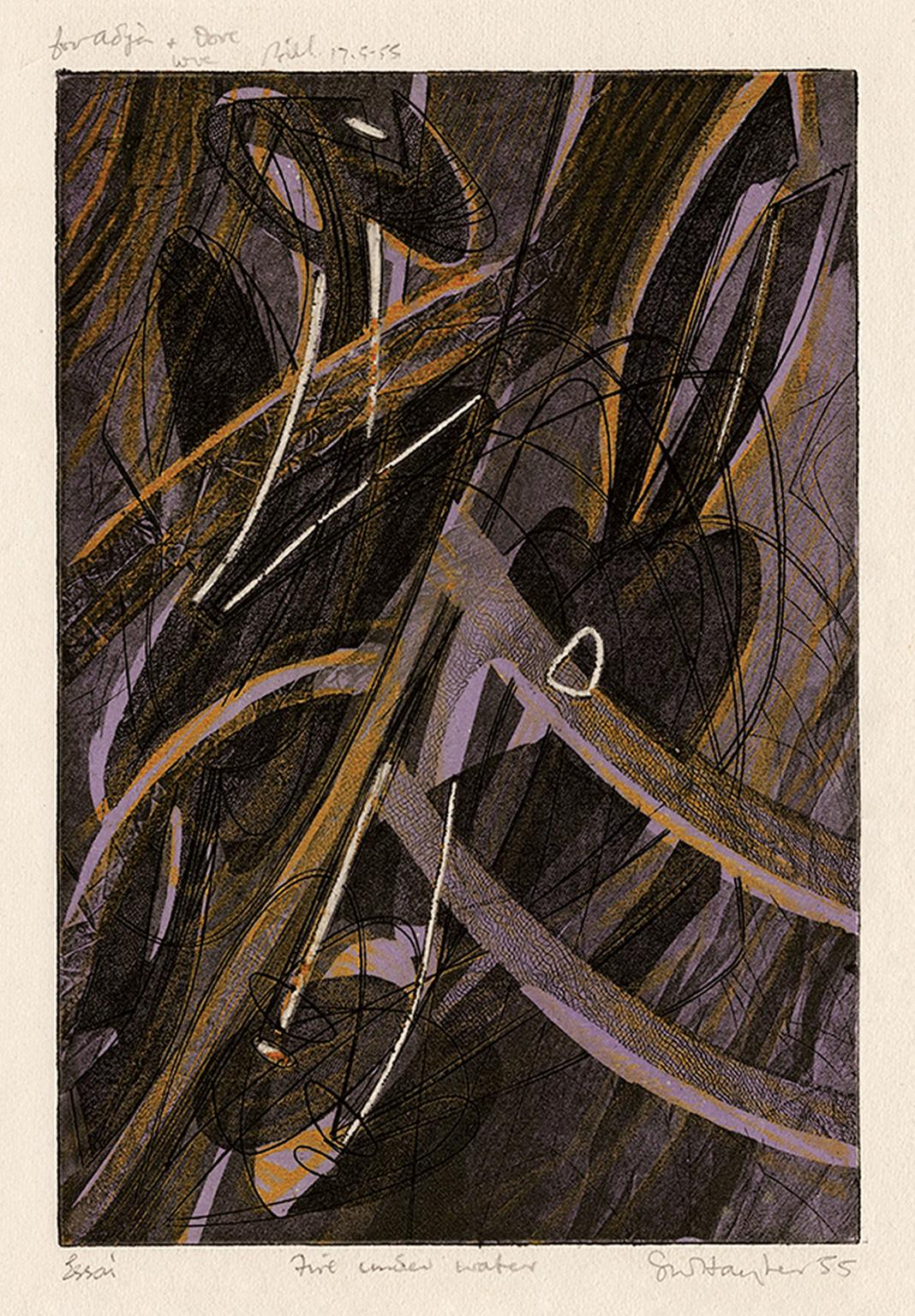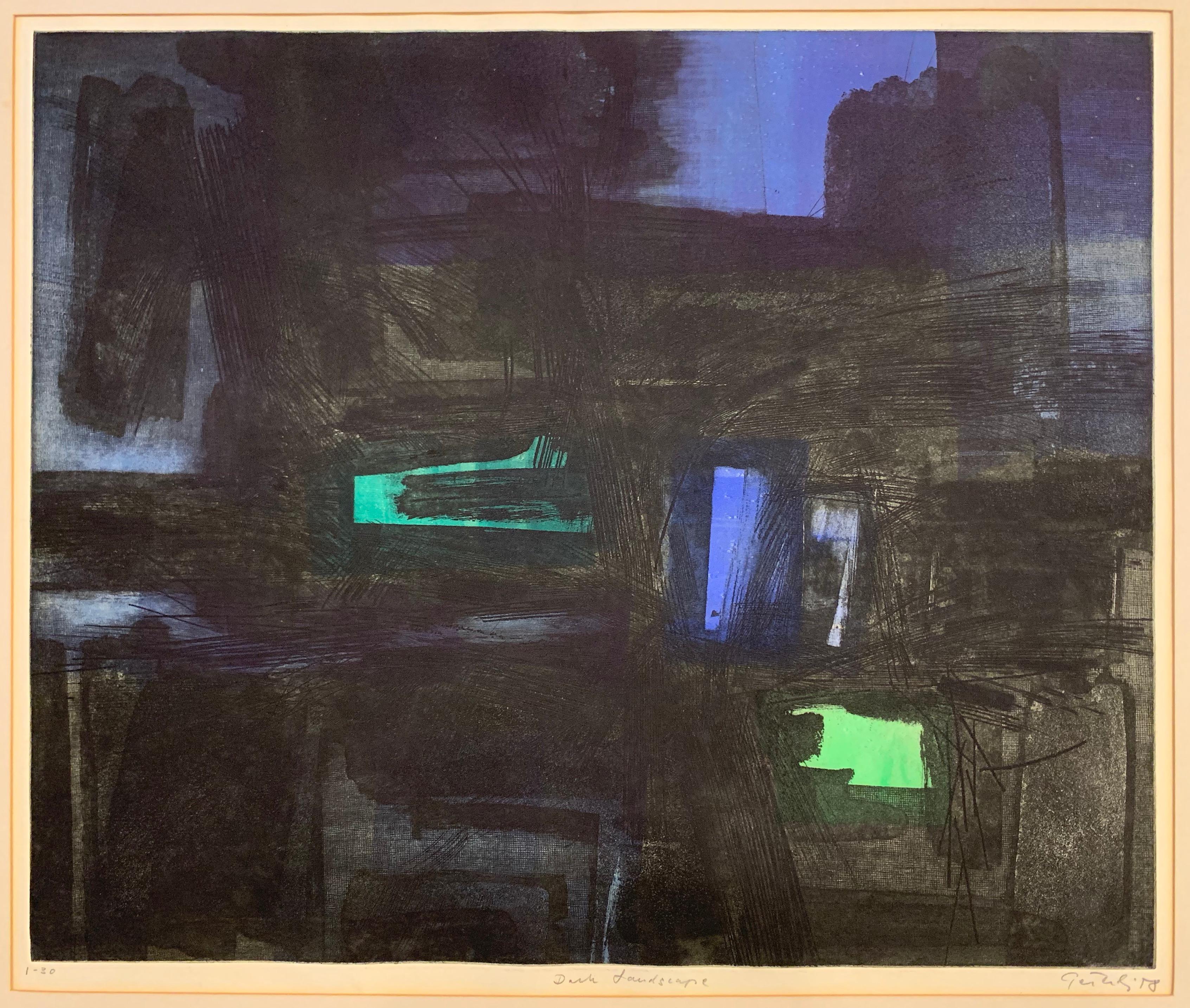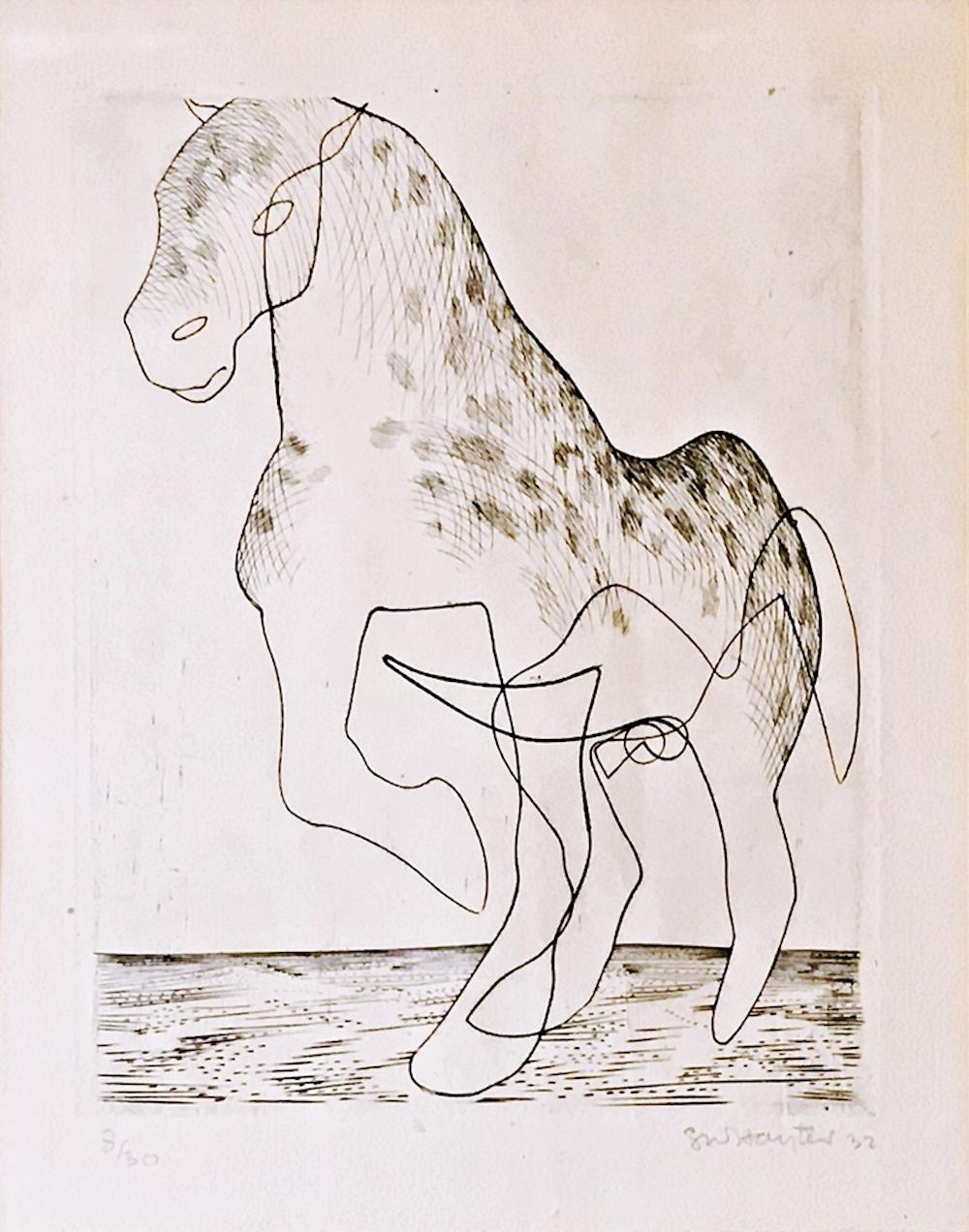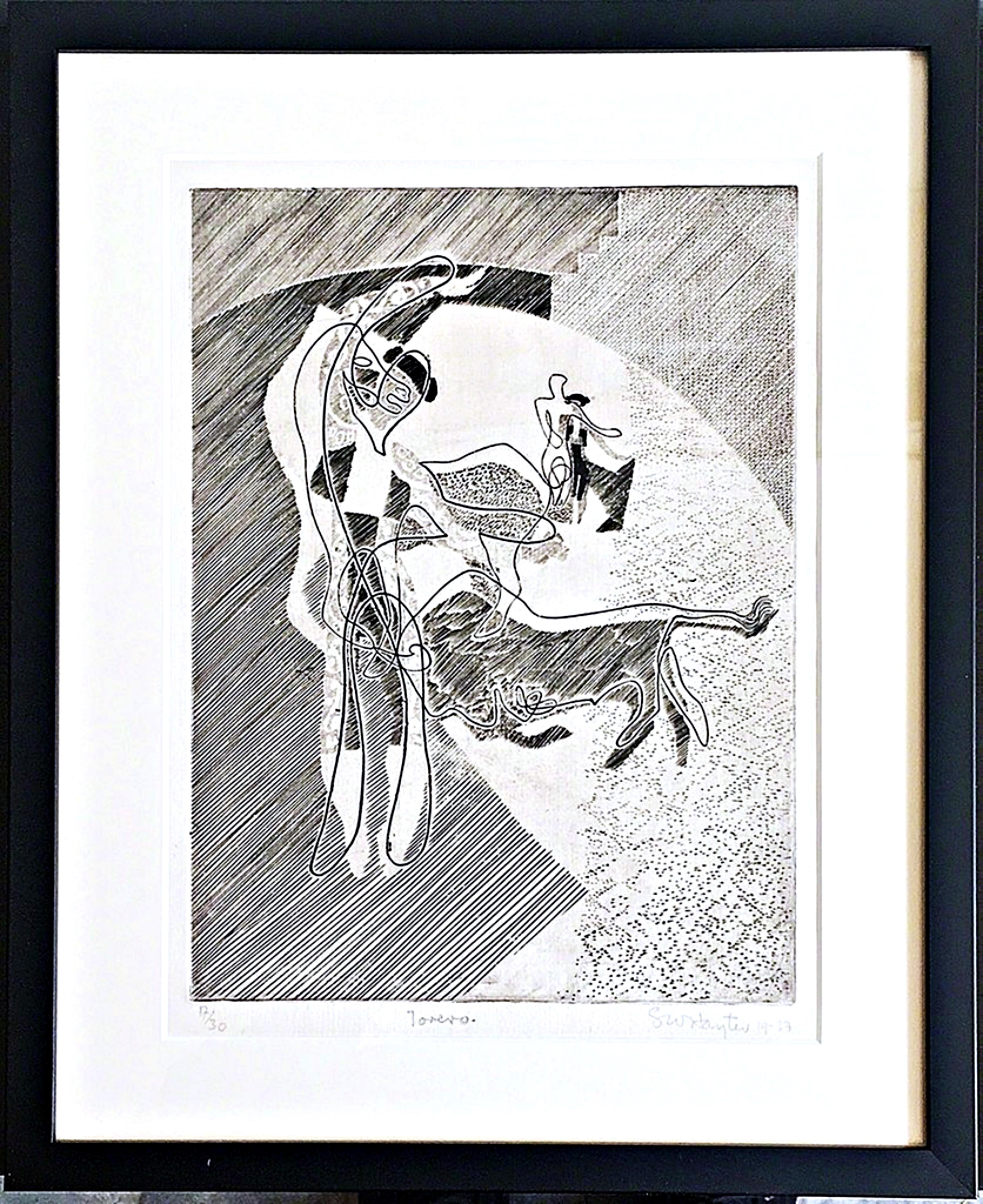Items Similar to Untitled
Want more images or videos?
Request additional images or videos from the seller
Henri GoetzUntitledc. 1960's
c. 1960's
About the Item
Untitled
Engraving, drypoint & carborundum, c. 1960's
Signed and numbered in pencil (see photos)
Edition: 25 (9/25)
Printed by the artist
Condition: Adhesive residue on the verso top margin from previous matting.
Image/plate size: 9 1/4 x 6 15/16 inches
Sheet size: 12 3/4 x 9 7/8 inches
Note: Goetz was born in the United States, moved to Paris and became a noted Surrealist artist and journalist of the surrealist movement. As a printmaker, Goetz invented carborundum printmaking in the 1960’s. In 1968, La gravure au carborundum, a treatise on carborundum printing, was published by the Maeght Gallery. It was prefaced by Joan Miró. Goetz created many abstract prints using this method. Other artists such as Antoni Clavé, Antoni Tàpies, and in particular Joan Miró, employed carborundum printing in their work.
Henri Bernard Goetz (1909-1989)
Henri Bernard Goetz was born 29 September 1909 in New York, in a family of French and American origin. He studied at Harvard University and the Grand Central Art School before moving to Paris in 1930 where he continued his studies at the Academies Julian and Academies Ozenfant in Montparnasse.
After a brief return to the US in the early 1930’s he settled permanently in France, taking a Parisian studio next to Victor Brauner. With Brauner Goetz became involved with the Surrealist group and was soon a highly accomplished exponent. 1935 would be a year of major importance for Goetz: he exhibited for the first time at the Salon des Surindependants, he married the Dutch painter Christine Boumeester and he met Hans Hartung, who would become a close lifelong friend. In 1937 Goetz held his first solo show at Galerie Van Leer, Paris.
During the war, having neglected to become naturalized French citizens, Goetz and Boumeester became illegal aliens and both worked in the resistance movement. They printed leaflets on a simple printing press and created posters to paste on walls around Paris. However, they primarily worked to forge identity documents. They were nearly captured in 1942 and forced to flee to the south of France which had already become something of a colony for displaced artists, and remarkably resilient creative spirits. After the Liberation of Paris in 1944, Goetz and his wife were able to return.
The post-war period would witness the consecration of Henri Goetz’s career. He gained increasing critical acclaim, while his work became more abstracted, freed from any surrealist references. He became highly celebrated holding over a hundred one man shows in France and abroad.
He taught at many schools before finally founding the Académie Goetz in André Lhote’s old building. Goetz never charged money for his lessons. in 1967 was awarded the Chevalier des Arts and in 1968 he accepted a teaching position at École des Beaux-Arts, but the school was closed due to student strikes two weeks later. He then moved to work at Paris 8 University, where he taught painting and etching classes.
His work can now be found in numerous museums and institutions throughout the world including the Musée National d’Art Moderne, Centre Georges Pompidou, Paris; Musée Goetz-Boumeester, Villefranche-sur-Mer; San Francisco Museum of Art; National Art Foundation, Illinois; Phoenix Art Museum; San Diego Museum; Museum of New Mexico, Santa Fe; Museum of Budapest; Jerusalem Museum.
Courtesy Alba-Avis
- Creator:Henri Goetz (1909 - 1989, American, French)
- Creation Year:c. 1960's
- Dimensions:Height: 9.25 in (23.5 cm)Width: 6.94 in (17.63 cm)
- Medium:
- Movement & Style:
- Period:
- Condition:
- Gallery Location:Fairlawn, OH
- Reference Number:
About the Seller
5.0
Recognized Seller
These prestigious sellers are industry leaders and represent the highest echelon for item quality and design.
Platinum Seller
These expertly vetted sellers are 1stDibs' most experienced sellers and are rated highest by our customers.
Established in 1978
1stDibs seller since 2013
713 sales on 1stDibs
Typical response time: 1 hour
Associations
International Fine Print Dealers Association
- ShippingRetrieving quote...Ships From: Fairlawn, OH
- Return PolicyA return for this item may be initiated within 10 days of delivery.
More From This SellerView All
- Omar’s CupBy Bernard ChildsLocated in Fairlawn, OHAnnotated in pencil on detached bottom margin: “Printed by the artist’s own press at 4 rue d’universite, Paris, Sept. 1958” Edition: 10 (8/10) Printed in red, black with gold leaf highlights Dedicated in pencil by the artist: “For Alice and Albert Turner...Category
1950s Abstract Expressionist Abstract Prints
MaterialsDrypoint
- UntitledBy Henri GoetzLocated in Fairlawn, OHUntitled Engraving, drypoint & carborundum, c. 1960's Signed and numbered in pencil lower margin (see photos) Edition: 25 (9/25) Printed by the artist Condition: Adhesive residue on the verso top margin from previous matting. Image/Plate size: 4 1/2 x 4 inches Note: Goetz was born in the United States, moved to Paris and became a noted Surrealist artist and journalist of the surrealist movement. As a printmaker, Goetz invented carborundum printmaking in the 1960’s. In 1968, La gravure au carborundum, a treatise on carborundum printing, was published by the Maeght Gallery. It was prefaced by Joan Miró. Goetz created many abstract prints using this method. Other artists such as Antoni Clavé, Antoni Tàpies, and in particular Joan Miró, employed carborundum printing in their work. Henri Bernard Goetz (1909-1989) Henri Bernard Goetz was born 29 September 1909 in New York, in a family of French and American origin. He studied at Harvard University and the Grand Central Art School before moving to Paris in 1930 where he continued his studies at the Academies Julian and Academies Ozenfant in Montparnasse. After a brief return to the US in the early 1930’s he settled permanently in France, taking a Parisian studio next to Victor Brauner. With Brauner Goetz became involved with the Surrealist group and was soon a highly accomplished exponent. 1935 would be a year of major importance for Goetz: he exhibited for the first time at the Salon des Surindependants, he married the Dutch painter Christine Boumeester and he met Hans Hartung, who would become a close lifelong friend. In 1937 Goetz held his first solo show at Galerie Van Leer, Paris. During the war, having neglected to become naturalized French citizens, Goetz and Boumeester became illegal aliens and both worked in the resistance movement. They printed leaflets on a simple printing press and created posters to paste...Category
1960s Abstract Expressionist Abstract Prints
MaterialsEngraving
- UntitledBy Henri GoetzLocated in Fairlawn, OHUntitled Signed in pencil lower right (see photo) Edition: 25 (9/25) (see photo) Engraving, drypoint & carborundum Printed by the artist Condition: Excellent, slight residue on reverse Sheet: 9 7/8 x 12 3/4" Image/Plate: 5 x 7" Note: Goetz was born in the United States, moved to Paris and became a noted Surrealist artist and journalist of the surrealist movement. As a printmaker, Goetz invented carborundum printmaking in the 1960’s. In 1968, La gravure au carborundum, a treatise on carborundum printing, was published by the Maeght Gallery. It was prefaced by Joan Miró. Goetz created many abstract prints using this method. Other artists such as Antoni Clavé, Antoni Tàpies, and in particular Joan Miró, employed carborundum printing in their work. Henri Bernard Goetz (1909-1989) Henri Bernard Goetz was born 29 September 1909 in New York, in a family of French and American origin. He studied at Harvard University and the Grand Central Art School before moving to Paris in 1930 where he continued his studies at the Academies Julian and Academies Ozenfant in Montparnasse. After a brief return to the US in the early 1930’s he settled permanently in France, taking a Parisian studio next to Victor Brauner. With Brauner Goetz became involved with the Surrealist group and was soon a highly accomplished exponent. 1935 would be a year of major importance for Goetz: he exhibited for the first time at the Salon des Surindependants, he married the Dutch painter Christine Boumeester and he met Hans Hartung, who would become a close lifelong friend. In 1937 Goetz held his first solo show at Galerie Van Leer, Paris. During the war, having neglected to become naturalized French citizens, Goetz and Boumeester became illegal aliens and both worked in the resistance movement. They printed leaflets on a simple printing press and created posters to paste...Category
1960s Abstract Expressionist Abstract Prints
MaterialsDrypoint, Etching
- Red MountainBy Louisa ChaseLocated in Fairlawn, OHRed Mountain Three color lithograph, 1986-7 Signed, titled and dated in pencil lower right Annotated "B.A.T." for Bon a Tire lower left corner This example is the printers guide for printing the editon of 40 Printed on BFK Rives paper Printed at Derriere L'Etoile Studios, New York Printer: Maurice Sanchez Condition: Excellent, never framed Image/Sheet size: 45 1/4 x 30 inches Louisa Chase came to prominence in the 1980's as one of the outstandingNeo-Expressionist painters. Her work then was characterized by bold colors and brush strokes, often incorporating natural elements and fragments of the figure. Louisa Chase's works have been featured in gallery and museum shows in Cologne, Nurnberg, Luzem, Switzerland, Toronto, and Tokyo, and various galleries and museums throughout the US. She has also been featured at the American Pavillion at the 1984 Venice Biennale. Also in 1984, the Institute of Contemporary Art in Boston organized as travelling exhibition of her work. In 1997, the Madison Art Center organized a retrospective of her prints, Louisa Chase: Prints, 1981-1996. She has been a featured artist at the University of Wisconsin's Tandem Press and at the Tamarind Press; ahe was also invited to do a print for Lincoln Center in New York City. The recipient of two grants from the National Endowment for the Arts, Chase's works are in the permanent collections of such museum as The Museum of Modern Art, the Metropolitan Museum of Art, The Whitney Museum of American Art (New York), The Brooklyn Museum of Arts, The Corcoran Gallery and The Library of Congress (Washington D.C.), The Walker Art Center (Minneapolis), the Mount Holyoke College Art Museum, the Denver Museum of Art, and the Chazin Museum of Art of the University of Wisconsin, Madsion and the Madison Museum of Contemporary Art (Madison WI). Bibliography: Elizabeth Armstrong, Painters who print (Minnapolis: Walker Art Center, 1984); Ruth S...Category
1980s Abstract Expressionist Abstract Prints
MaterialsLithograph
- Baby, BabyBy Louisa ChaseLocated in Fairlawn, OHBaby, Baby Etching & aquatint printed in colors, 1991 Signed, dated, titled & numbered in pencil (see photos) Edition: 35 (4/35) plus 10 AP Condition: Excellent, colors fresh Image...Category
1990s Abstract Expressionist Abstract Prints
MaterialsAquatint
- Ancient Landscape II (Ancient City)By Louise NevelsonLocated in Fairlawn, OHAncient Landscape II (Ancient City) Etching and drypoint, 1953-1955 Signed and titled in pencil by the artist; (see photo) Annotated: "E130 A/1" in pencil lower right Estate stamp v...Category
1950s Abstract Expressionist Abstract Prints
MaterialsEtching
You May Also Like
- Large Italian Aquatint Etching Francesco Clemente Neo Expressionist Avant GardeBy Francesco ClementeLocated in Surfside, FLFrancesco Clemente (Italian b. 1952), 'This side up / Telemone #2, 1981 Medium: Intaglio hard ground etching, color aquatint, drypoint, and soft-ground etching with chine collé (ha...Category
1980s Abstract Expressionist Abstract Prints
MaterialsDrypoint, Etching, Aquatint, Intaglio
- 'Flight to Tomorrow' — Mid-Century American Modernism — Atelier 17By Minna CitronLocated in Myrtle Beach, SCMinna Citron, 'Flight to Tomorrow', aquatint and engraving, edition unknown but small, 1948. Signed, titled, dated, and annotated 'engr & aqua' in pencil. A superb, richly-inked impression with selectively wiped plate tone, on heavy cream wove paper, the full sheet with margins (1 3/4 to 3 1/2 inches), in excellent condition. Image size 6 7/8 x 8 7/16 inches (175 x 214 mm); sheet size 11 1/8 x 14 7/8 inches (283 x 378 mm). Matted to museum standards, unframed. Literature: The Women of Atelier 17, Modernist Printmaking in MidCentury New York, Christina Weyl, Yale University Press, 2019, p. 186. Collections: Davis Museum (Wellesley), Five Colleges and Historic Deerfield Museum Consortium, Harvard Art Museums, Museum of Fine Arts, Boston, Palmer Museum of Art (Penn State...Category
1940s Abstract Expressionist Abstract Prints
MaterialsEngraving, Aquatint
- 'Feu sous L'eau' (Fire Under Water) —Mid-century Modernism, Atelier 17By Stanley William HayterLocated in Myrtle Beach, SCStanley William Hayter, 'Feu sous L'eau (Fire Under Water)', color engraving, soft-ground etching and scorper with yellow silkscreen, 1955, edition 50 plus 10 artist proofs, Black & Moorhead 221. Signed, titled 'Fire Under Water', dated and annotated 'Essai' in pencil. Dedicated in the artist’s hand 'for Adja & Dove WH Bill 17–5–55' in the top margin. A superb, richly inked impression with fresh colors, on heavy, cream wove paper; wide margins (2 1/2 to 3 7/8 inches), in excellent condition. One of 10 artist’s proofs. Image size 10 3/16 x 7 inches; sheet size 18 1/8 x 12 1/4 inches. Matted to museum standards, unframed. ABOUT THIS WORK In 1950 Hayter returned to Paris and reopened Atelier 17. Works such as 'Fire Under Water' reveal newfound influences, such as that of the Ardèche area of southern France, where he acquired a house in 1951 and frequently visited. Hayter took great interest in the flowing Escoutay River, an experience that parallels the artist and co-director of Atelier 17 Krishna Reddy’s interest in depicting water. While some forms in this print evoke the natural world, the palette of contrasting tones of purple, yellow, black, and white reflects Hayter’s belief in using color intuitively to express emotions and evoke feelings. The sharp white relief lines from the paper and the textural effects realized through soft-ground etching operate in tandem with the sweeping curves and bold colors to give the composition a sense of vitality and dynamism. —edited from the Metropolitan Museum of Art Published by 'La Jeune Gravure Contemporaine', Paris. Impressions of this work are in the following collections: British Museum, Metropolitan Museum of Art, National Gallery of Art. ABOUT THE ARTIST Stanley William Hayter (1901-1988) was a British painter and printmaker associated in the 1930s with Surrealism and from 1940 onward with Abstract Expressionism. Regarded as one of the most significant printmakers of the 20th century, Hayter founded the legendary Atelier 17 studio in Paris, now known as Atelier Contrepoint. Among the artists he is credited with influencing are Pablo Picasso, Alberto Giacometti, Joan Miró, Alexander Calder, and Marc Chagall. The hallmark of the workshop was its egalitarian structure, breaking sharply with the traditional French engraving studios by insisting on a cooperative approach to labor and technical discoveries. In 1929 Hayter was introduced to Surrealism by Yves Tanguy and André Masson, who, with other Surrealists, worked with Hayter at Atelier 17. The often violent imagery of Hayter’s Surrealist period was stimulated in part by his passionate response to the Spanish Civil War and the rise of Fascism. He organized portfolios of graphic works to raise funds for the Spanish cause, including Solidarité (Paris, 1938), a portfolio of seven prints, one of them by Picasso. Hayter frequently exhibited with the Surrealists during the 1930s but left the movement when Paul Eluard was expelled. Eluard’s poem Facile Proie (1939) was written in response to a set of Hayter’s engravings. Other writers with whom Hayter collaborated included Samuel Beckett and Georges Hugnet. Hayter joined the exile of the Parisian avant-garde in 1939, moving with his second wife, the American sculptor Helen Phillips...Category
1950s Abstract Expressionist Abstract Prints
MaterialsEngraving, Etching
- Dark Landscape (abstract expressionist)By Gabor F. PeterdiLocated in Wilton Manors, FLGabor Peterdi (1915-2001). Dark Landscape, 1958. Etching, engraving and aquatint with five stenciled colors. Image measures 20 x 24 inches. Signed, date...Category
Mid-20th Century Abstract Expressionist Abstract Prints
MaterialsEngraving, Etching, Aquatint
- Big Horse (Black & Moorhead 46)By Stanley William HayterLocated in New York, NYStanley William Hayter Big Horse (Black & Moorhead 46), 1932 Engraving & Drypoint on antique white Canson Vidalon laid paper affixed to original matting Hand signed, numbered and dat...Category
1930s Abstract Expressionist Animal Prints
MaterialsEngraving, Drypoint
- Torero (de-accessioned from the Denver Art Museum)By Stanley William HayterLocated in New York, NYStanley William Hayter Torero (de-accessioned from the Denver Art Museum), 1929-1933 Engraving on laid paper, third (final) state, on heavy BFK Rives off-white wove paper Signed, tit...Category
1930s Abstract Expressionist Abstract Prints
MaterialsEngraving, Etching

